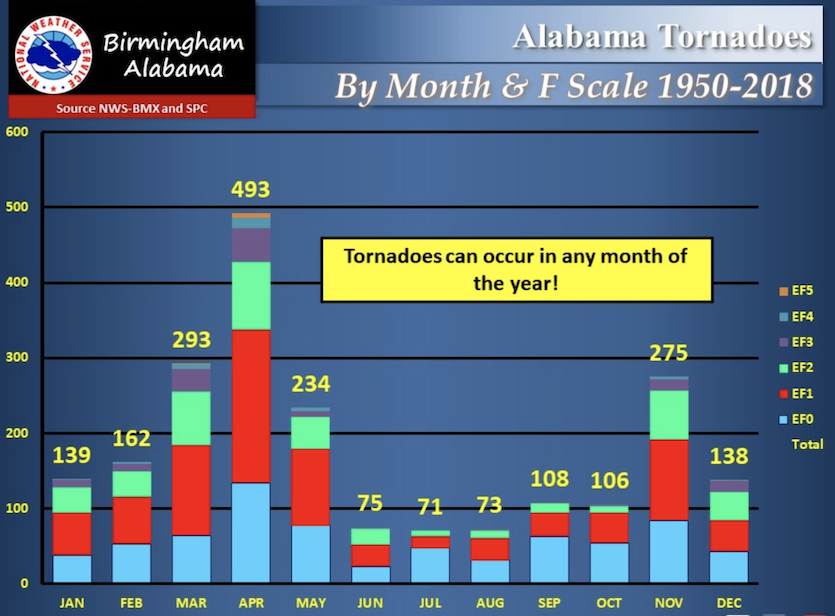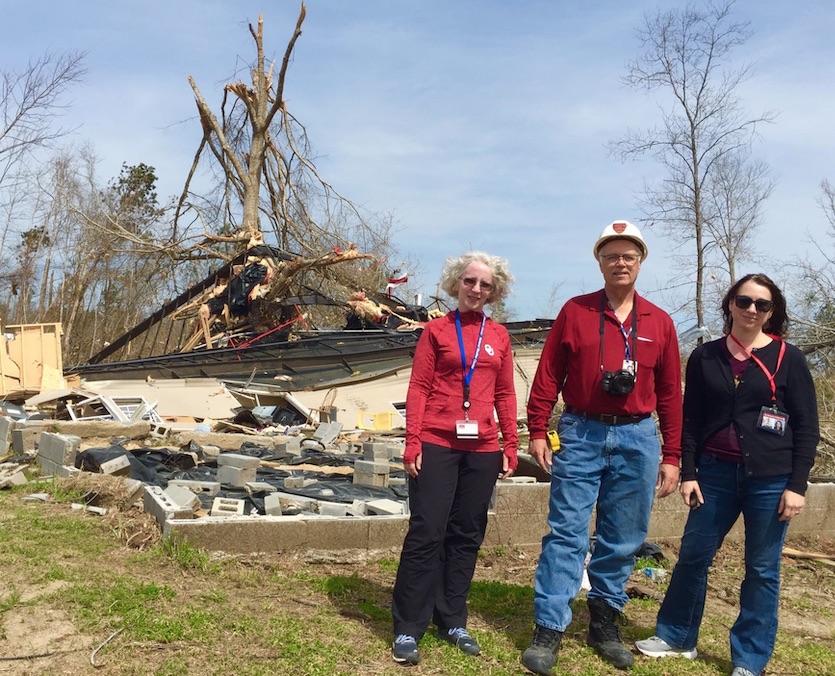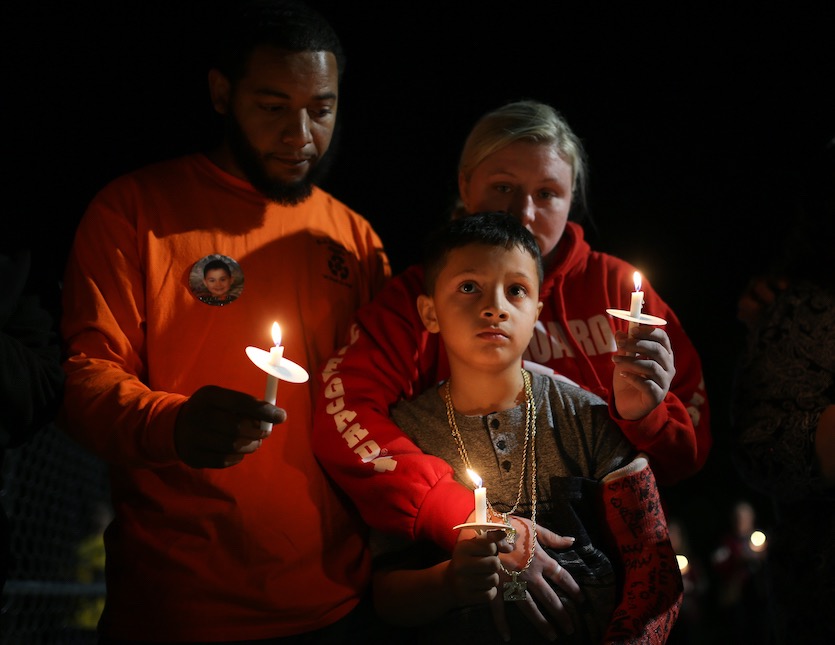| Above: A home sits upside down three days after a devastating EF4 tornado tore through southern Lee County, Alabama, on March 3, 2019, killing 23 people and causing at least 90 injuries. Image credit: Alex Wong/Getty Images. |
Chasing a tornado is one thing. It’s a whole different matter if a tornado is heading toward your home. How do you deal with the threat? And exactly what happens if the tornado actually hits? A new NOAA-funded study will spend the next two years delving into those questions.
The project is bringing together damage experts, meteorologists, and social scientists to find out how people behave when they’re at home during an imminent tornado threat, and what they see, hear and feel when a tornado actually strikes. The goal is “linking survivor stories with forensic engineering”, as described by Daphne LaDue, a senior research scientist at the University of Oklahoma’s Center for Analysis and Prediction of Storms and one of the principal investigators.
The project is part of VORTEX-SE (Verification of the Origins of Rotation in Tornadoes EXperiment-Southeast), the ongoing NOAA-led study of tornadoes and society in the nation’s most twister-vulnerable region. By September, severe weather season is ramping down across most of the U.S., but parts of the Deep South are coming off their quietest three months of the year on average and getting ready for the tornadoes that fall, winter, and spring can deliver.
“Tornado season really has become year-round. We don’t really stand down,” says Laura Myers, director of the Center for Advanced Public Safety at the University of Alabama’s College of Engineering.
 |
| Figure 1. Based on data for 1950–2018, tornadoes become increasingly frequent in Alabama and vicinity as you move into autumn into winter and on into spring, with a peak in April. Although the state sees a minimum in the three months of climatological summer, tornadoes can strike even during these months. Image credit: NWS/Birmingham. |
Tim Marshall (Haag Engineering), a leading expert on tornado damage, came up with the idea for the new project, which carried out a pilot project early this year before the two-year grant came through.
“Combining social scientists with damage surveyors is a win-win. We learn a lot from each other,” says Marshall. “They can interview the people affected by the tornado and help fill in the gaps about when the building was built, answer questions about where items were before the tornado, and find out where people were during the storm. I can also use the valuable time onsite to study the damage rather than spend it interviewing people.”
LaDue and Marshall joined OU associate professor of psychology Lara Mayeux and Auburn University assistant professor of engineering David Roueche for the pilot project shortly after the disastrous March 3 tornado outbreak that took at least 23 lives in southeast Alabama. Group members went to dozens of affected home sites and collected both engineering assessments and interviews at 23 of them. Some of the most evocative moments came when residents described the experience of a tornado hitting their homes—including the sense their structure was “sort of breathing,” a sensation more than one interviewee mentioned.
“People describe things like seeing a door bowing in,” LaDue said. “Some of them were able to describe the sound of the roof popping off, nail by nail. That kind of thing can help confirm that perhaps there was a weak connection in one corner and then a cascading failure.”
 |
| Figure 2. Tim Marshall, Daphne LaDue, and Lara Mayeux at one of the manufactured homes destroyed in Lee County, Alabama, by an EF4 tornado on March 3, 2019. Image credit: Courtesy Tim Marshall. |
For the full two-year project, LaDue, Mayeux, and Roueche will be joined by Frank Lombardo, an assistant professor of civil and environmental engineering at the University of Illinois at Urbana-Champaign. Lombardo will study the characteristics of the winds that affected homes. Meanwhile, LaDue and Mayeux will conduct interviews to understand residents’ awareness of the threat, their sheltering decisions, and what they saw, heard, or felt during the tornado. Mayeux is especially interested in how people talk to each other just before and during a tornado strikes, including how adults talk to their children.
According to Lombardo, “research after some recent significant tornado events suggested that residents directly in the path either did not take protective action or only did so after they received environmental or physical cues from the tornado (i.e., way too late) even though warnings were adequate.”
That left Lombardo with several questions: “What were these environmental and physical cues? Can we learn anything about the tornado itself and/or building damage from their accounts of these cues? And how can we, as engineers, increase survivability based on the seemingly large proportion of people who had mere seconds to take shelter?”
LaDue plans to explore how various cues come into play during the critical minutes of a tornado threat, including National Weather Service warnings, TV coverage, and contact from family and friends as well as first-person impressions of the overall weather situation and the storm itself. The team will also be analyzing how residents cope with the aftermath of a tornado strike.
 |
| Figure 3. The parents and brother of Armando Hernandez, 6, the youngest victim of the deadly EF4 tornado that passed through Lee County, Alabama, on March 3, 2019, participate in a candlelight vigil for the 23 victims on March 11, 2019 in Beauregard, AL. Image credit: Elijah Nouvelage/Getty Images. |
Another VORTEX-SE project involving Myers, LaDue, and Jack Friedman, a research scientist at OU’s Center for Applied Social Research, will put scientists in people’s homes while a tornado threat is actually unfolding. “We think it may be the first study of its kind,” Myers said. “We’re going to observe up to 30 households and how they actually react to a severe weather event.”
To make the project as non-intrusive as possible, the researchers and graduate students will establish relationships beforehand with the volunteer subjects, then focus on observing and taking notes during the severe weather itself.
Even a forecast “bust” will be of value, says Myers: “What do people do in a non-event?”
On the other hand, an imminent tornado strike will have its own challenges: “What do we do, especially if the family’s not making the best choice?” The team might even choose to stand down if a severe weather setup looks as fearsome as the Southeast’s Super Outbreak of April 2011, which killed some 360 people and caused more than $12 billion in damage (2018 USD). With a threat that dire, says Myers, “there’s not much variation” in how people respond.
Direct contact with residents is an important piece of the VORTEX-SE research portfolio, says Myers, who hopes the work will lead to improved outreach materials and strategies. “It’s really important to understand why people do what they do. What better way to understand what is needed than to talk to the public, especially as they’re experiencing it?"



